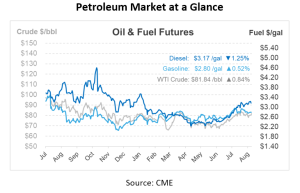
What Is It – Sand and Grit Traps
Have you ever wondered what happens to the dirt and debris from the extraction of crude oil or even when you dispose of wastewater at places such as quick lube centers or car washes? That’s where sand and grit traps come into play. Today, FUELSNews will be exploring sand and grit traps and how they are used in the energy industry.
What are sand and grit traps?
Sand and grit traps are mechanisms specifically designed to remove sand, grit, and other heavy particles from wastewater and other fluids to protect equipment and optimize the efficiency of downstream processes. These are especially common in settings like refineries, wastewater treatment facilities, and other processing plants. Sand and grit traps are a staple in businesses like car washes or car dealerships. Here is how they fit the mold of the petroleum and energy industries:
Drilling Operations: As drilling fluids (or “mud”) are used to stabilize wellbores, they can accumulate sand and grit. These particles can damage pumps and other equipment, making sand and grit traps crucial for their removal.
Oil and Gas Production: Hydrocarbons extracted from wells, especially from sandstone reservoirs, often contain sand, known as “sand production.” This sand can erode equipment and pipelines, so sand separators are used near the wellhead to prevent damage.
Hydraulic Fracturing: In fracking, a mixture containing water, sand, and chemicals is injected into shale formations. The returning fluid, “flow back,” contains both the initial sand and additional formation particles. Sand and grit traps are essential to separate these solids from the flow back water before their disposal or reuse.
Refineries: Crude oil contains various impurities, including sand. Before refining, sand and grit traps, alongside other separators, ensure the removal of these particles, safeguarding refining equipment like reactors and heat exchangers.
Wastewater Treatment: Both petroleum and energy operations produce wastewater laden with sand and other solids. Before treating or discharging this water, these solids are removed to ensure treatment efficacy and environmental safety.
How Do They Work?
A typical sand and grit trap contains two chambers. The primary chamber receives the water collected from the facility. Here, oil naturally floats to the top, while the solid waste, including debris, sand, or dirt, sinks to the bottom. Strategically positioned in the middle of these chambers, below the floating oil but above the settled grit, is a pipe. This pipe channels relatively clean water into the secondary chamber. Once there, gravity takes over again, further separating any remaining oil or sand from the water. Finally, the water exits through a middle pipe towards the sewage system.
Why is Cleaning these Traps Important?
Different state and local plumbing codes regulate the maintenance and disposal of dirt from these traps, making their upkeep crucial. When neglected, overflowing traps can transport sand and grit to the broader sewer systems, leading to expensive blockages.
Further complicating matters, the semi-liquid waste in these traps can become contaminated with hazardous substances like benzene and lead. Proper disposal becomes not just a matter of efficiency but of safety. Businesses are accountable for the manner by which their waste is disposed. It’s recommended that businesses cleanout or service their sand and grit traps once or twice a year.
Select Environmental, a Mansfield Service Partners company, has been trusted to safely and reliably handle both hazardous and non-hazardous materials for over 30 years. Partnering with a trustworthy waste disposal company is paramount, especially if issues arise. A reliable waste management company, like Select Environmental, keeps accurate records that can vindicate your business if complications occur. Our team of industry professionals is ready to partner with you. Call us today or visit the website to learn more.

This article is part of Daily Market News & Insights
MARKET CONDITION REPORT - DISCLAIMER
The information contained herein is derived from sources believed to be reliable; however, this information is not guaranteed as to its accuracy or completeness. Furthermore, no responsibility is assumed for use of this material and no express or implied warranties or guarantees are made. This material and any view or comment expressed herein are provided for informational purposes only and should not be construed in any way as an inducement or recommendation to buy or sell products, commodity futures or options contracts.





